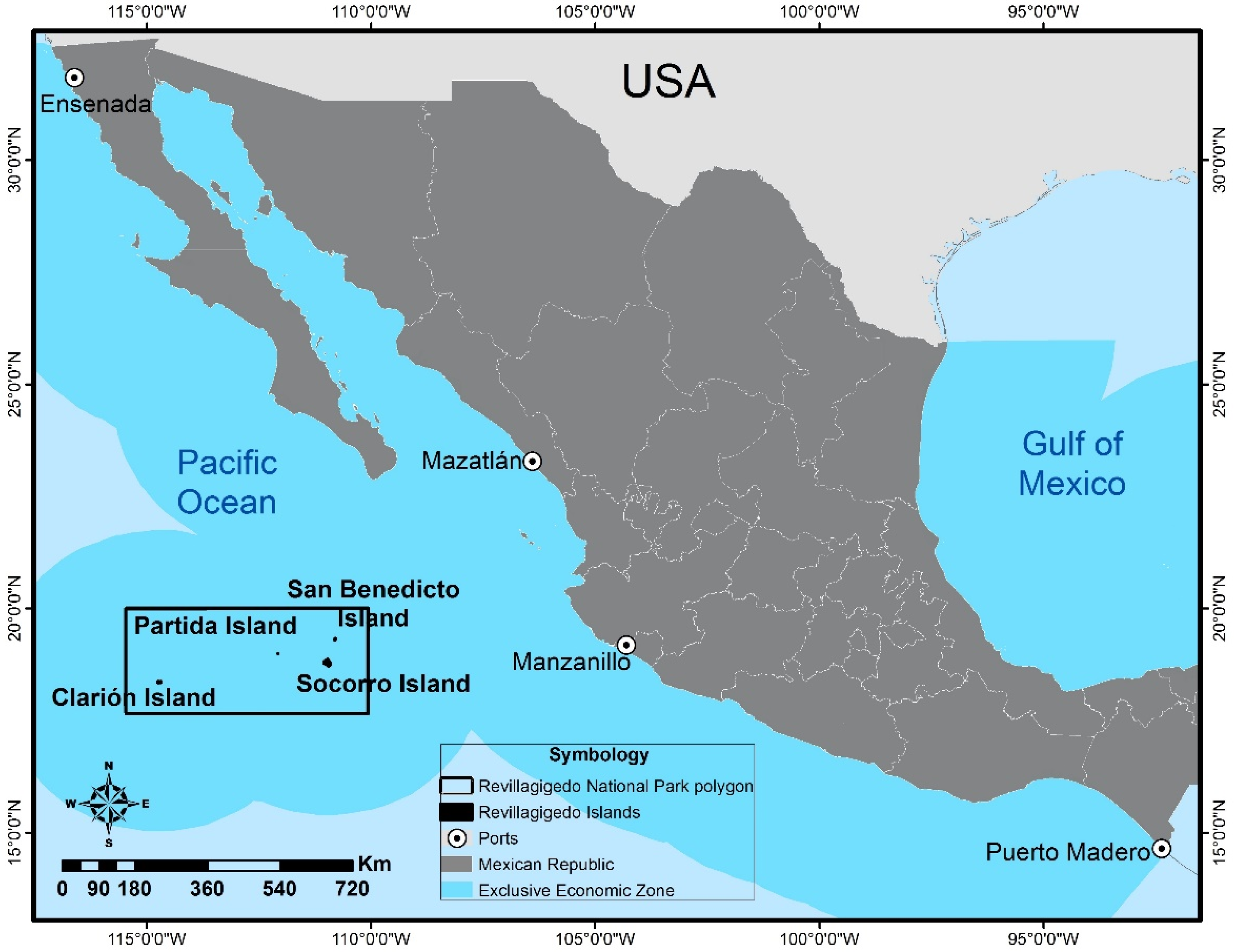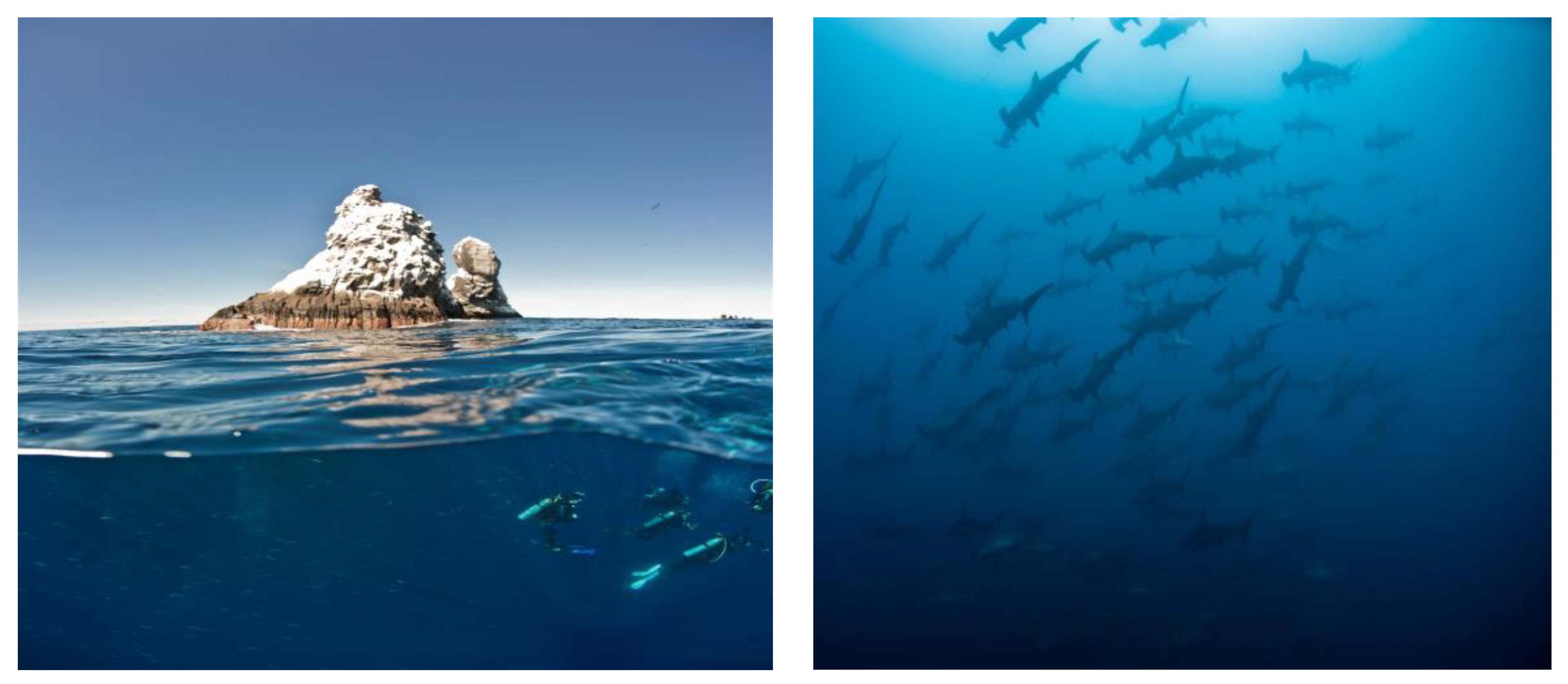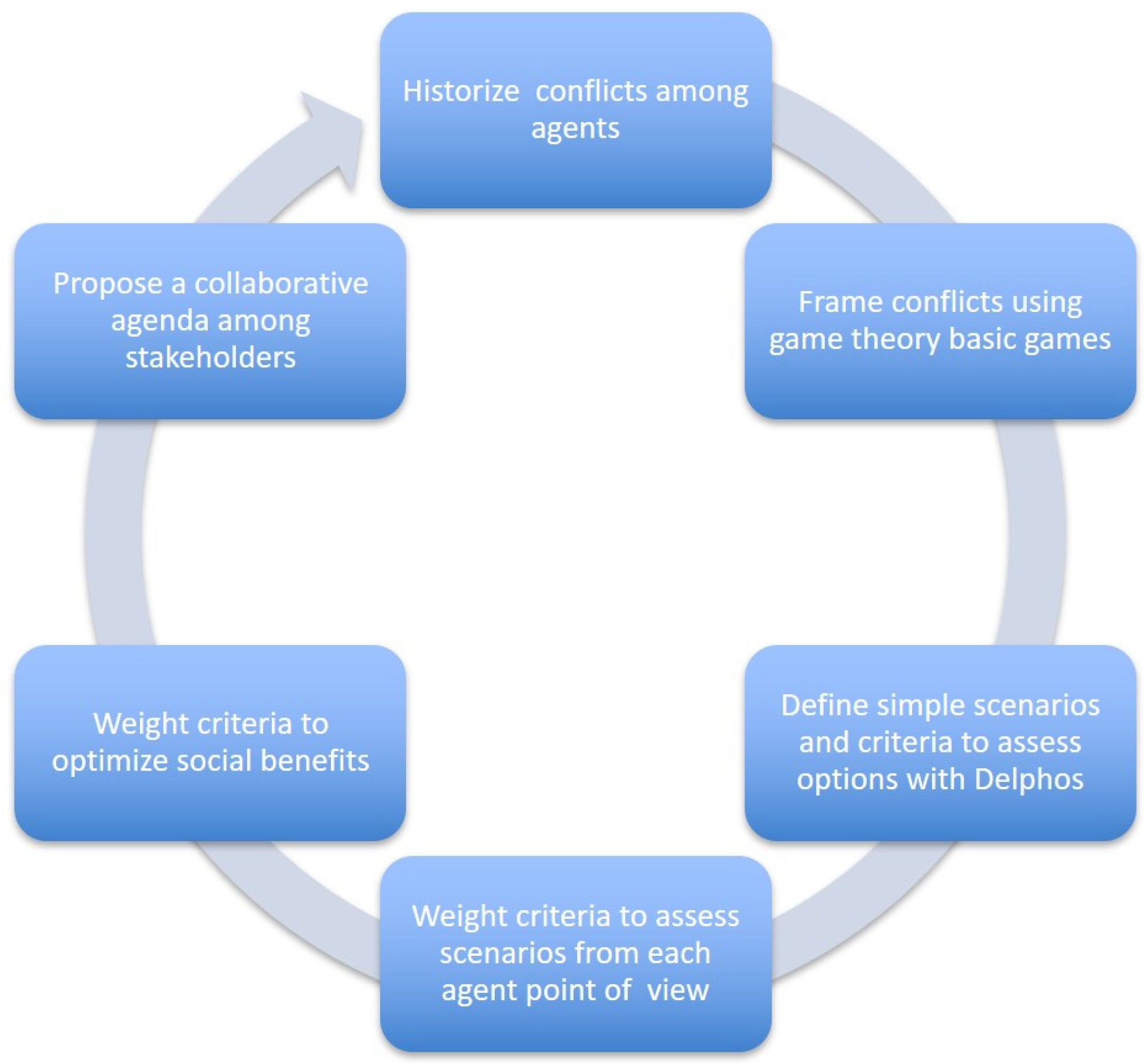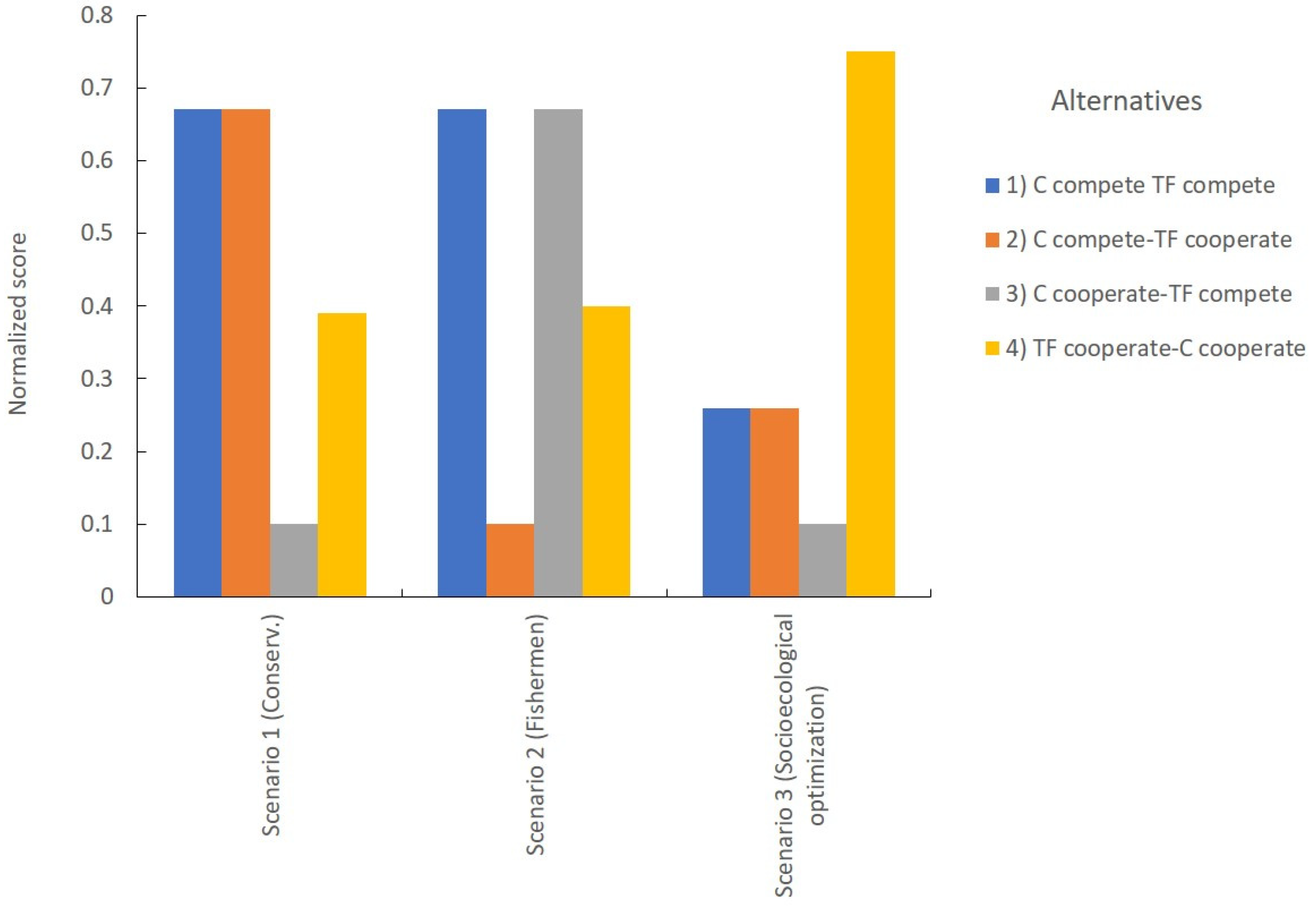Large-Scale Marine Protected Areas by Decree: Lessons Learned from the Creation of the Revillagigedo Marine Park
Abstract
:1. Introduction
2. Materials and Methods
3. Results
3.1. Historical Reconstruction
3.1.1. An Overview of the Mexican Tuna Industry in Relation to Marine Conservation
3.1.2. An Overview of the Conservation Sector Promoting Global and Mexican Marine Protected Areas
3.1.3. An Overview of the Consequences of the Fast-Track Declaration
Trading Quantity for Quality
Alienation of Potential Partners for Marine Conservation
Masking the Most Important Threats to the Marine Environment
3.2. A Prisoner’s Dilemma Model for the Revillagigedo Marine Park
3.3. Multicriteria Decision Analysis
- Scenario 1 (conservationists-oriented perspective): decision is taken based exclusively on the importance of creating a large marine reserve (Size of the reserve). We performed the analysis only taking into account this criterion, which was the most important taken into account by this sector during the decree process.
- Scenario 2 (tuna fishermen-oriented perspective): decision is taken just by avoiding the costs incurred by fishers of creating a no-take zone as fishing ground loss. We performed the analysis only taking into account this criterion.
- Scenario 3 (socio-ecological optimization): decision is taken with the criteria we propose as the minimum necessary to be considered in designing a network of no-take zones in a large marine reserve such as the one established around the Revillagigedo Archipelago.
4. Discussion
Author Contributions
Funding
Institutional Review Board Statement
Informed Consent Statement
Data Availability Statement
Acknowledgments
Conflicts of Interest
References
- Lubchenco, J.; Grorud-Colvert, K. Making waves: The science and politics of ocean protection. Science 2015, 350, 382–383. [Google Scholar] [CrossRef] [PubMed]
- Agardy, T.; Claudet, J.; Day, J.C. ‘Dangerous Targets’ revisited: Old dangers in new contexts plague marine protected areas. Aquat. Conserv.-Mar. Freshw. Ecosyst. 2016, 26, 7–23. [Google Scholar] [CrossRef]
- Barnes, M.D.; Glew, L.; Wyborn, C.; Craigie, I.D. Prevent perverse outcomes from global protected area policy. Nat. Ecol. Evol. 2018, 2, 759–762. [Google Scholar] [CrossRef]
- O’Leary, B.C.; Ban, N.C.; Fernandez, M.; Friedlander, A.M.; Garcia-Borboroglu, P.; Golbuu, Y.; Guidetti, P.; Harris, J.M.; Hawkins, J.P.; Langlois, T.; et al. Addressing Criticisms of Large-Scale Marine Protected Areas. Bioscience 2018, 68, 359–370. [Google Scholar] [CrossRef] [PubMed] [Green Version]
- Singleton, R.L.; Roberts, C.M. The contribution of very large marine protected areas to marine conservation: Giant leaps or smoke and mirrors? Mar. Pollut. Bull. 2014, 87, 7–10. [Google Scholar] [CrossRef]
- Bennett, N.J.; Teh, L.; Ota, Y.; Christie, P.; Ayers, A.; Day, J.C.; Franks, P.; Gill, D.; Gruby, R.L.; Kittinger, J.N.; et al. An appeal for a code of conduct for marine conservation. Mar. Policy 2017, 81, 411–418. [Google Scholar] [CrossRef]
- Christie, P.; Bennett, N.J.; Gray, N.J.; Wilhelm, T.A.; Lewis, N.; Parks, J.; Ban, N.C.; Gruby, R.L.; Gordon, L.; Day, J.; et al. Why people matter in ocean governance: Incorporating human dimensions into large-scale marine protected areas. Mar. Policy 2017, 84, 273–284. [Google Scholar] [CrossRef] [Green Version]
- De Santo, E.M. Missing marine protected area (MPA) targets: How the push for quantity over quality undermines sustainability and social justice. J. Environ. Manag. 2013, 124, 137–146. [Google Scholar] [CrossRef]
- Spalding, M.D.; Meliane, I.; Milam, A.; Fitzgerald, C.; Hale, L.Z. Protecting Marine Spaces: Global Targets and Changing Approaches. Ocean Yearb. Online 2013, 27, 213–248. [Google Scholar] [CrossRef] [Green Version]
- Lewis, N.; Day, J.; Wilhelm, T.; Wagner, D.; Gaymer, C.; Parks, J.; Friedlander, A.; White, S.; Sheppard, C.; Spalding, M.; et al. Large-Scale Marine Protected Areas: Guidelines for Design and Management; IUCN: Gland, Switzerland, 2017. [Google Scholar]
- Toonen, R.J.; Wilhelm, T.A.; Maxwell, S.M.; Wagner, D.; Bowen, B.W.; Sheppard, C.R.C.; Taei, S.M.; Teroroko, T.; Moffitt, R.; Gaymer, C.F.; et al. One size does not fit all: The emerging frontier in large-scale marine conservation. Mar. Pollut. Bull. 2013, 77, 7–10. [Google Scholar] [CrossRef]
- Saenz-Arroyo, A.; Roberts, C.M.; Torre, J.; Carino-Olvera, M.; Hawkins, J.P. The value of evidence about past abundance: Marine fauna of the Gulf of California through the eyes of 16th to 19th century travellers. Fish Fish. 2006, 7, 128–146. [Google Scholar] [CrossRef]
- IUCN. IUCN World Heritage Evaluations 2016. IUCN Evaluations of Nominations of Natural and Mixed Properties to the World Heritage List. 2016, p. 176. Available online: http://whc.unesco.org/archive/2014/whc14-38com-inf8B2-en.pdf (accessed on 1 February 2022).
- Lagerquist, B.A.; Mate, B.R.; Ortega-Ortiz, J.G.; Winsor, M.; Urban-Ramirez, J. Migratory movements and surfacing rates of humpback whales (Megaptera novaeangliae) satellite tagged at Socorro Island, Mexico. Mar. Mammal Sci. 2008, 24, 815–830. [Google Scholar] [CrossRef]
- Holroyd, G.L.; Trefry, H.E. The Importance of Isla Clarion, Archipelago Revillagigedo, Mexico, for Green Turtle (Chelonia mydas) Nesting. Chelonian Conserv. Biol. 2010, 9, 305–309. [Google Scholar] [CrossRef]
- DOF. DECRETO por el que se Declara como Área Natural Protegida, con el Carácter de Parque Nacional, la Región Conocida como Revillagigedo, Localizada en el Pacífico Mexicano. Presidencia de la República. Mexico City. 2017. Available online: https://www.dof.gob.mx/nota_detalle.php?codigo=5505736&fecha=27/11/2017 (accessed on 1 February 2022).
- Colyvan, M.; Justus, J.; Regan, H.M. The conservation game. Biol. Conserv. 2011, 144, 1246–1253. [Google Scholar] [CrossRef]
- Voogd, J.H. Multicriteria Evaluation for Urban-and-Regional Planning; Pion Limited: London, UK, 1983. [Google Scholar]
- Janssen, R.; van Herwijnen, M. Definite. A System to Support Decisions on a FINITE Set of Alternatives; Springer: Amsterdam, The Netherlands, 1994. [Google Scholar]
- Darji, V.P.; Rao, R.V. Application of AHP/EVAMIX Method for Decision Making in the Industrial Environment. Am. J. Oper. Res. 2013, 3, 18. [Google Scholar] [CrossRef] [Green Version]
- Linkov, I.; Moberg, E. Multi-Criteria Decision Analysis: Environmental Applications and Case Studies; CRC Press: Boca Raton, FL, USA, 2011. [Google Scholar]
- Geneletti, D. Multicriteria Analysis for Environmental Decision-Making; Anthem Press: London, UK, 2019; p. 123. [Google Scholar]
- Esmail, B.A.; Geneletti, D. Multi-criteria decision analysis for nature conservation: A review of 20 years of applications. Methods Ecol. Evol. 2018, 9, 42–53. [Google Scholar] [CrossRef] [Green Version]
- Kiker, G.A.; Bridges, T.S.; Varghese, A.; Seager, T.P.; Linkov, I. Application of Multicriteria Decision Analysis in Environmental Decision Making. Integr. Environ. Assess. Manag. 2005, 1, 95–108. [Google Scholar] [CrossRef]
- Munguia-Vega, A.; Green, A.L.; Suarez-Castillo, A.N.; Espinosa-Romero, M.J.; Aburto-Oropeza, O.; Cisneros-Montemayor, A.M.; Cruz-Pinon, G.; Danemann, G.; Giron-Nava, A.; Gonzalez-Cuellar, O.; et al. Ecological guidelines for designing networks of marine reserves in the unique biophysical environment of the Gulf of California. Rev. Fish Biol. Fish. 2018, 28, 749–776. [Google Scholar] [CrossRef] [Green Version]
- Anonimo. Primera reunión de la mesa redonda sobre la problemática del mar celebrada el 30 de Mayo de 1983. Boletín De La Soc. Mex. De Geogr. Y Estadística 1983, CXXXIII, 1–38. [Google Scholar]
- Morán-Angulo, R.E.; Flores-Campaña, L.M. La Pesca en Sinaloa: Breve Historia y Búsqueda del Episteme. Ra Ximhai 2015, 11, 57–72. Available online: https://www.redalyc.org/articulo.oa?id=46135409005 (accessed on 1 February 2022). [CrossRef]
- Gonzalez-Pacheco, C.; Delgado-Martinez, I. El Atún, El Embargo y el Tratado de Libre Comercio. Momento Económico 1991, 55, 8–13. Available online: http://bvirtual.ucol.mx/descargables/548_atun_embargo.pdf/ (accessed on 1 March 2022).
- Whyknot, D. Flipper Victorious. In San Diego Reader; 1996; Available online: https://www.sandiegoreader.com/news/1996/may/23/cover-flipper-victorious/# (accessed on 1 March 2022).
- Chairez, J.A. La Historia de la Pesca de Atun en México; Editorial Chariéz: Ensenada, Mexico, 1996; Volume 3, p. 366. [Google Scholar]
- TV-Conapesca, C. La Marcha al Mar; Krauze, E., Ed.; TELEVISA-CLIO TV: Mexico City, Mexico, 2011. Available online: https://www.youtube.com/watch?v=LlHxFAYdXKY (accessed on 1 March 2022).
- Hall, M.A.; Alverson, D.L.; Metuzals, K.I. By-catch: Problems and solutions. Mar. Pollut. Bull. 2000, 41, 204–219. [Google Scholar] [CrossRef]
- Hall, M.A. An ecological view of the tuna--dolphin problem: Impacts and trade-offs. Rev. Fish Biol. Fish. 1998, 8, 1–34. [Google Scholar] [CrossRef]
- Leenhardt, P.; Cazalet, B.; Salvat, B.; Claudet, J.; Feral, F. The rise of large-scale marine protected areas: Conservation or geopolitics? Ocean Coast. Manag. 2013, 85, 112–118. [Google Scholar] [CrossRef]
- Fulton, S.; (Comunidad y Biodiversidad A.C., Guaymas, Mexico). Personal Communication, 2018.
- DOF. DECRETO por el que se Declara Área Natural Protegida, con el Carácter de Reserva de la Biosfera, la Región Conocida como Caribe Mexicano. Presidencia de la República. Mexico City. 2016. Available online: http://www.dof.gob.mx/nota_detalle.php?codigo=5464450&fecha=07/12/2016&print=true (accessed on 1 February 2022).
- DOF. DECRETO por el que se Declara Área Natural Protegida, con el Carácter de Reserva de la Biosfera, la Región Conocida como Pacífico Mexicano Profundo. Presidencia de la República. Mexico City. 2016. Available online: http://www.dof.gob.mx/nota_detalle.php?codigo=5464452&fecha=07/12/2016 (accessed on 1 February 2022).
- Sáenz-Arroyo, A.; Roberts, C.M.; Torre, J.; Cariño-Olvera, M.M.; Enríquez-Andrade, R. Rapidly shifting environmental baselines among fishers of the Gulf of California. Proc. R. Soc. Lond. Ser. B-Biol. Sci. 2005, 272, 1957–1962. [Google Scholar] [CrossRef] [PubMed] [Green Version]
- Sala, E.; Aburto-Oropeza, O.; Reza, M.; Paredes, G.; Lopez-Lemus, L.G. Fishing down coastal food webs in the Gulf of California. Fisheries 2004, 29, 19–25. [Google Scholar] [CrossRef]
- Televisa. El futuro de las Islas Revillagigedo. In Despierta con Carlos Loret; Mola, C.L.D., Ed.; 2017; Available online: https://www.youtube.com/watch?v=YRWamK3d4Bg (accessed on 1 March 2022).
- Redaccion. Busca México declarar Parque Nacional a Revillagigedo; Excelsior: Hong Kong, 2017; Available online: https://www.excelsior.com.mx/nacional/2017/10/05/1192861 (accessed on 1 March 2022).
- Agardy, T.; Bridgewater, P.; Crosby, M.P.; Day, J.; Dayton, P.K.; Kenchington, R.; Laffoley, D.; McConney, P.; Murray, P.A.; Parks, J.E.; et al. Dangerous targets? Unresolved issues and ideological clashes around marine protected areas. Aquat. Conserv.-Mar. Freshw. Ecosyst. 2003, 13, 353–367. [Google Scholar] [CrossRef]
- Moreno, P. Mexico Lider en Protección de Áreas Marinas. El Universal, 29 January 2018. Available online: http://www.eluniversal.com.mx/nacion/sociedad/mexico-lider-en-proteccion-de-areas-marinas (accessed on 1 March 2022).
- Robles, Y.A.; Montes, L.a.; Vega, A.J. Caracterización de la captura de tiburones por la pesca artesanla en los manglares de David, Golfo de Chiriquí, Pacifico de Panamá. Tecnociencia 2015, 17, 11–30. [Google Scholar]
- Alejo-Plata, M.d.C.; Ramos-Carrillo, S.; Cruz-Ruiz, J.L. La pesquería artesanal del tiburón en Salina Cruz, Oaxaca, México. Ciencia y Mar 2006, 30, 37–51. [Google Scholar]
- Halpern, B.S.; Lester, S.E.; Kellner, J.B. Spillover from marine reserves and the replenishment of fished stocks. Environ. Conserv. 2010, 36, 268–276. [Google Scholar] [CrossRef] [Green Version]
- Boerder, K.; Bryndum-Buchholz, A.; Worm, B. Interactions of tuna fisheries with the Galapagos marine reserve. Mar. Ecol. Prog. Ser. 2017, 585, 1–15. [Google Scholar] [CrossRef] [Green Version]
- MSC. Northeastern Tropical Pacific Purse Seine Yellowfin and Skipjack Tuna Fishery. Available online: https://fisheries.msc.org/en/fisheries/northeastern-tropical-pacific-purse-seine-yellowfin-and-skipjack-tuna-fishery (accessed on 14 November 2018).
- Anonymous. Alianza de Pacífico por el Atún Sustentable.Plan de Acción MSC. Commitments to Sustainability: Our Action Plan. Available online: http://www.pacifictunaalliance.org/sustainability/msc-action-plan.html (accessed on 1 March 2022).
- Zavala, M. Pescadores se Manifiestan en Casa de Transcición de AMLO. El Universal; 2018. Available online: http://www.eluniversal.com.mx/nacion/sociedad/pescadores-se-manifiestan-en-casa-de-transicion-de-amlo (accessed on 1 March 2022).
- Ramirez-Cuevas, G. AMLO echa abajo privatización del Mar de Cortés. In Regenaración; 2018; Available online: https://regeneracion.mx/amlo-echara-abajo-privatizacion-del-mar-de-cortes/ (accessed on 1 March 2022).
- Hilborn, R. Marine biodiversity needs more than protection. Nature 2016, 535, 224–226. [Google Scholar] [CrossRef] [PubMed] [Green Version]
- Hughes, T.P. Catastrophes, Phase Shifts, and Large-Scale Degradation of a Caribbean Coral Reef. Science 1994, 265, 1547–1551. [Google Scholar] [CrossRef] [PubMed] [Green Version]
- Hughes, T.P.; Barnes, M.L.; Bellwood, D.R.; Cinner, J.E.; Cumming, G.S.; Jackson, J.B.C.; Kleypas, J.; van de Leemput, I.A.; Lough, J.M.; Morrison, T.H.; et al. Coral reefs in the Anthropocene. Nature 2017, 546, 82–90. [Google Scholar] [CrossRef] [PubMed]
- Sáenz-Arroyo, A. Parrot fishes, climate change and coastal development: Insight from local people to understand the future of coral reefs. In preparation.
- Rodríguez-Martínez, R.E.; Banaszak, A.T.; McField, M.D.; Beltrán-Torres, A.U.; Alvarez-Filip, L. Assessment of Acropora palmata in the Mesoamerican Reef System. PLoS ONE 2014, 9, e96140. [Google Scholar] [CrossRef] [Green Version]
- Rubio-Cisneros, N.T.; Moreno-Báez, M.; Glover, J.; Rissolo, D.; Sáenz-Arroyo, A.; Götz, C.; Salas, S.; Andrews, A.; Marín, G.; Morales-Ojeda, S.; et al. Poor fisheries data, many fishers, and increasing tourism development: Interdisciplinary views on past and current small-scale fisheries exploitation on Holbox Island. Mar. Policy 2019, 100, 8–20. [Google Scholar] [CrossRef]
- Arias-González, J.E.; Fung, T.; Seymour, R.M.; Garza-Pérez, J.R.; Acosta-González, G.; Bozec, Y.-M.; Johnson, C.R. A coral-algal phase shift in Mesoamerica not driven by changes in herbivorous fish abundance. PLoS ONE 2017, 12, e0174855. [Google Scholar] [CrossRef] [Green Version]
- Camacho-Cruz, K.; Ortiz-Hernández, M.C.; Sáchez, A.; Carillo-Bibriezca, L.E.; de Jesus-Navarrete, A. Water Quality in Mexican Caribbean: Analysis of Benthic Bioindicattors and Physicochemical Parameters of Water. Rev. Int. Contam. Ambient. 2018, 34, 65–70. [Google Scholar]
- CIATT. Los Atunes, Peces Picudos, Y Otras Especies Pelágicas en el Océano Pacífico Oriental en 2016. Available online: https://www.iattc.org/Meetings/Meetings2017/IATTC-92/PDFs/Docs/_Spanish/IATTC-92-04a_La-pesqueria-en-2016-y-la-condicion-de-las-poblaciones-de-atunes-y-peces-picudos.pdf (accessed on 1 March 2022).
- Sumaila, U.R. A review of game-theoretic models of fishing. Mar. Policy 1999, 23, 1–10. [Google Scholar] [CrossRef]
- Axelrod, R. The Evolution of Cooperation; Basic Books: Cambrige, MA, USA, 1984; Reprinted 2006; p. 241. [Google Scholar]
- Worm, B.; Barbier, E.B.; Beaumont, N.; Duffy, J.E.; Folke, C.; Halpern, B.S.; Jackson, J.B.C.; Lotze, H.K.; Micheli, F.; Palumbi, S.R.; et al. Impacts of Biodiversity Loss on Ocean Ecosystem Services. Science 2006, 314, 787–790. [Google Scholar] [CrossRef] [Green Version]
- Gill, D.A.; Mascia, M.B.; Ahmadia, G.N.; Glew, L.; Lester, S.E.; Barnes, M.; Craigie, I.; Darling, E.S.; Free, C.M.; Geldmann, J.; et al. Capacity shortfalls hinder the performance of marine protected areas globally. Nature 2017, 543, 665. [Google Scholar] [CrossRef] [PubMed]
- Newman, D.; Paasi, A. Fences and neighbours in the postmodern world: Boundary narratives in political geography. Prog. Hum. Geogr. 1998, 22, 186–207. [Google Scholar] [CrossRef]
- Ostrom, E. Collective action and the evolution of social norms. J. Econ. Perspect. 2000, 14, 137–158. [Google Scholar] [CrossRef]
- Mace, G.M. Whose conservation? Science 2014, 345, 1558–1560. [Google Scholar] [CrossRef] [PubMed]





| Criteria | Attributes | Description |
|---|---|---|
| Size of the LSMPA | Quantitative: Measure in km2 Analyzed as a benefit | Both in the scenario where conservationists compete and found cooperation or competition from fishers, conservationists managed to pass the 148,000 km2 as LSMPA. In the scenario where conservationists do not compete for territory the value for this criterion is zero and in a theoretical compromised scenario we place half of the size of the reserve desired by the conservationists. |
| Fishing ground lost | Quantitative: measure in what the percentage of the area the industry expressed they might lose Analyze as a cost | The industry expressed that the polygon proposed by the conservation sector, which was finally approved, constitutes around 25% of the fishing area where they catch tuna. In the theoretical compromised scenario, we reduce this to half as in the size of the LSMPA protected areas proposed by conservationists. |
| Connectivity | Qualitative: Assessed in an ordinal scale Analyzed as a benefit |
|
| Funds for conserving vulnerable species | Quantitative: Measure in USD (Millions of dollars);Funds committed for the conservation of endangered species in the region Analyzed as a benefit | With the declaration of the Revillagigedo LSMPA neither the Mexican Government nor the NGOs promoting the decree, committed funds to make sure the polygon was going to revert some threats over vulnerable species such as sharks. For the MSC certification the tuna industry committed 10 million dollars to improve their conservation performance in particular with sharks by-catch, committing to have zero mortality for the recertification [49]. In a theoretical compromised scenario, the industry was open to create a collaborative strategy to better understand shark species life history (E.G marking sharks that are released alive). |
| Fishing over floating objects | Qualitative: Assessed by the literature to score regional importance for this type of fishing strategy Analyzed as a cost | IATTC reports indicate that the strategy of placing floating objects is more frequent in the high seas than in other sites where islands and seamounts are found [60]. Displacing the Mexican tuna industry from where they catch 25% of the harvest implies they should expand their operations to the high seas to preserve their productivity. Thus, in this case, the actual LSMPA would have promoted:
|
| International political support | Qualitative: Assessed by the extent of the time inverted in the creation and operation of the LSMPA Analyzed as a benefit |
|
| National political support | Qualitative: Assessed by the extend of the government support to the LSMPA regardless the political party in the administration Analyzed as a benefit |
|
| Alienation of potential partners | Qualitative: Assessed in a binary scale Assessed as a benefit |
|
| CRITERIA | |||||||||
| No take marine reserve Benefit | Fishing ground loss Cost | Connectivity Benefit | Funds for conserving vulnerable species Benefit | Fishing over floating objects Cost | International political support Benefit | National political support Benefit | Alienation of potential partners Benefit | ||
| km2 of no take reserve | % | (1) None (2) Mediocre (3) With potential | Millions of USD | (1) Moderate (2) Strong | (1) None (2) Fast and brief (3) With potential to create allies | (1) None (2) Fast and brief (3) With potential to create allies | (1) Alienated (2) Collaboration | ||
| ALTERNATIVES | Alternative 1 (C Compete-TF Compete) | 148,000 | 25 | Mediocre | 0 | Strong | Fast and brief | None | Alienated |
| Alternative 2 (C Compete-TF Cooperate) | 148,000 | 25 | Mediocre | 0 | Strong | Fast and brief | None | Alienated | |
| Alternative 3 (C Cooperate-TF Compete) | 0 | 0 | None | 0 | Moderate | None | Fast and brief | Alienated | |
| Alternative 4 (TF Cooperate-C Cooperate) | 74,000 | 12.5 | With potential | 10 | Moderate | With potential to create allies | With potential to create allies | Collaboration | |
Publisher’s Note: MDPI stays neutral with regard to jurisdictional claims in published maps and institutional affiliations. |
© 2022 by the authors. Licensee MDPI, Basel, Switzerland. This article is an open access article distributed under the terms and conditions of the Creative Commons Attribution (CC BY) license (https://creativecommons.org/licenses/by/4.0/).
Share and Cite
Saenz-Arroyo, A.; Camacho-Valdez, V. Large-Scale Marine Protected Areas by Decree: Lessons Learned from the Creation of the Revillagigedo Marine Park. Sustainability 2022, 14, 4027. https://doi.org/10.3390/su14074027
Saenz-Arroyo A, Camacho-Valdez V. Large-Scale Marine Protected Areas by Decree: Lessons Learned from the Creation of the Revillagigedo Marine Park. Sustainability. 2022; 14(7):4027. https://doi.org/10.3390/su14074027
Chicago/Turabian StyleSaenz-Arroyo, Andrea, and Vera Camacho-Valdez. 2022. "Large-Scale Marine Protected Areas by Decree: Lessons Learned from the Creation of the Revillagigedo Marine Park" Sustainability 14, no. 7: 4027. https://doi.org/10.3390/su14074027
APA StyleSaenz-Arroyo, A., & Camacho-Valdez, V. (2022). Large-Scale Marine Protected Areas by Decree: Lessons Learned from the Creation of the Revillagigedo Marine Park. Sustainability, 14(7), 4027. https://doi.org/10.3390/su14074027






